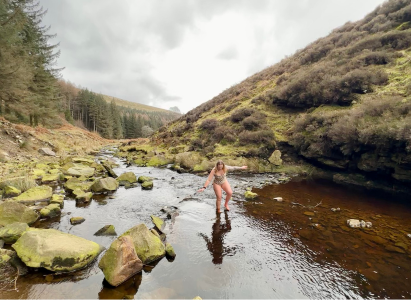
An Introduction To Wild Swimming
Fancy getting out more this year? Whether you're an avid swimmer or you simply enjoy the mindfulness that comes with exploring nature, wild swimming could be your new favourite outdoor hobby.
In this guide to wild swimming, we'll cover everything you need to know to get started, including what constitutes wild swimming, the benefits, what to bring and how to stay safe whilst doing it.
Wild Swimming: Everything You Need To Know
What Is Wild Swimming?
In a nutshell, it's swimming in natural bodies of water like lakes, rivers, and waterfalls. Instead of swimming in a controlled environment like a pool, wild swimming lets you immerse yourself in the beauty and power of nature.
But why has it become so popular lately? Well, for starters, more and more people are discovering the benefits of wild swimming.
It's great for both your physical and mental health, contributing to an overall better sense of well-being. Plus, with the rise of outdoor and adventure activities, more and more people are on the lookout for new ways to explore the great outdoors.
Another reason for the growing popularity is that wild swimming is a great way to escape the crowded and busy gyms or public pools (even more so in the colder months), and have a more peaceful, calmer experience.
And let's not forget, with the power of social media, more and more people are starting to share pictures and videos of their wild swimming adventures, encouraging others to give it a try. (Including avid cold water swimmer @feather39, who has kindly donned one of our new changing robes and features in this guide.)
Health Benefits of Wild Swimming
Swimming in natural bodies of water like lakes and rivers can give your heart and lungs a workout, without putting too much stress on your joints. And because the water is usually colder than a pool, it can help to increase circulation and reduce muscle soreness.
Speaking of cold water, the experience can also give you an endorphin rush, which can help to reduce pain and improve your mood.
But wild swimming isn't just good for your body, it's also great for your mind.
Being in nature can help to reduce stress and anxiety, and the feeling of being surrounded by nature can have a really positive impact on your mood. Plus, wild swimming can be a meditative and grounding experience, allowing you to detach from your daily concerns and focus on the present moment.
Of course, as with any outdoor activity, wild swimming comes with certain risks. It's essential to be aware of the safety precautions and have the proper gear, especially if you're new to wild swimming. As long as you're prepared and stay safe, wild swimming can be a truly enjoyable and beneficial experience.
“For me cold water immersion in the wild takes us back to our primitive selves. Away from the burdens of technology and social media getting out into nature allows us to take a moment to breathe, to feel and bring our awareness back to ourselves. The cold also teaches us resilience while surrounded by beautiful nature and gives us all the tools we need to take on anything that life throws at us!”
Jefferson Cartmell, ProjectCold Founder
Wild Swimming Equipment & Kit List
If you're wondering what to wear wild swimming, it'll largely depend on the temperature. If you're planning on going in the height of summer, you'll likely be fine with your usual swimwear like a swimming costume or swim shorts, along with a towel to dry off with.
In the colder months, you'll be best off with a wetsuit as they're more effective at retaining your body heat. Of course you'll also need a towel, but if it's cold we'd also recommend bringing a changing robe, as this will help protect you from wind chill as well as providing some privacy when getting changed.
Here's a list of essentials to bring on your swimming trip:
- Wetsuit OR Swimming Costume / Swim Shorts
- Towel
- Changing Robe
- Swim Cap (preferably hi-vis)
- Aqua Shoes
- Goggles
- Gloves
- Extra Socks
- Mini First Aid Kit
- Sunscreen (when it's hot)
- A Flask (of tea)
- Earplugs (to avoid swimmer's ear)
- Waterproof Head Torch (if swimming at dawn/dusk)
Don't forget about the walk to and from your swimming spot.
After you've finished your dip you'll want to raise your temperature again, so coming along with plenty of layers to warm you up on the walk back is essential. Extras like a base layer and a fleece will go a long way under the usual t-shirt and jacket combo.
Staying Safe Whilst Wild Swimming
Don't Swim Alone
Swimming in a group will add a sense of safety, which is a welcome feeling on your first few swims as it's quite common to feel anxious without the security of being close to a pool wall. It also means that should anything happen, you've got some support nearby to rely on.
If you don't have a friend who fancies trying it out, you can always find an experienced group to tag along with on The Outdoor Swimming Society or Swimming.org. Plus, they'll be more familiar with local waters clean enough to swim in.
Find A Safe & Easy Access Point
Lots of wild swimming spots are quite unkempt, so they can be slippery to get in and out of the water.
Find somewhere sloped or shallow where you can keep your belongings and ease in to the water slowly, allowing you to acclimatise. Don't just plunge in somewhere you can't easily escape from.
Don't Swim Dehydrated
Make sure to drink up before hand, as you're more likely to experience cramp if you're not hydrated enough. You'll be particularly prone to this if you've hiked to your wild swimming spot, or you're out in the summer heat.
Swim When It's Warmer Out
If you're new to wild swimming, it's generally recommended to wait until around April onwards so that the water isn't dangerously cold.
January to March is the coldest time of year for cold open water swimming, but typically anything under 15 degrees can impede your breathing and movement along with the risk of experiencing cold water shock.
Cold water swimming is not something to be taken lightly. Even a single degree of temperature difference will feel much colder than the number might suggest, and you'll be affected even more if you're of a thin build.
Stick to swimming in the warmer months if you're just starting out, and perhaps have cold water swimming as a long term goal you can build up to as you gain more experience and acclimatise your body with the temperature. However, if you're certain about swimming in cold water, it's imperative to wear a wetsuit unless you've had lots of experience.
That being said, just because it's warm out doesn't mean that the water's safe to jump in - you can still get cold water shock in the summer, so before going for your swim, dip your feet in the water and slowly ease in to things. Splash some water on your hands and onto your body to get used to the temperature first.
Warm Up Inside Out
After your swim, it's important to get dry and dressed as quickly as possible, and try to warm yourself up from the inside out (hence the flask of tea we recommend bringing). Then it's time to get your body moving to build your core temperature back up.
Where To Go Wild Swimming
If you're looking to find places to try out wild swimming, there's plenty available online listed on Wildswimming.co.uk's Swim Map, but as a beginner it's a good idea to check out Facebook groups you can tag along with, allowing you to start out somewhere local. Then, once you're more acquainted, you could go wild swimming in the Peak District or Yorkshire Dales for some more scenic swims.
Alternatively, if you're local to Lancaster you could join Project Cold for a swim in Crook O'Lune.
